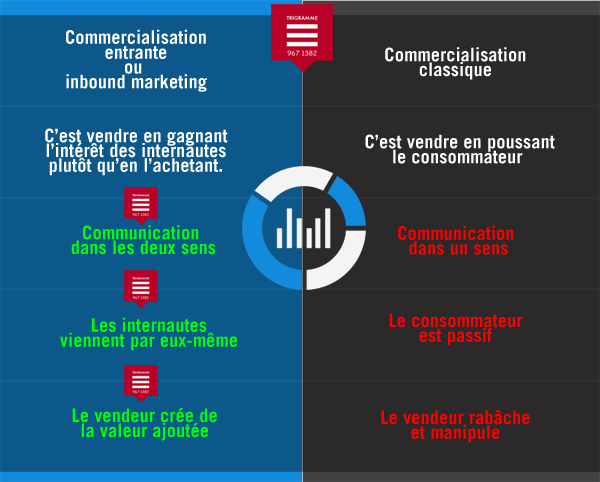Stories have been told since man could speak. To children to put them to sleep, in poems and songs to entertain, to seduce or make them dream, in books or films to stimulate the imagination or feel chills… and consumers to convince and retain them.
The rise of digital technology in everyday life at all levels has in no way undermined the art of writing, of moving, of making people dream, and the world of long-toothed marketing has not missed the shift offered by the web via ever richer media supports.
Whether we’re talking about storytelling (whose champions, solicited by the biggest brands, live like kings) or marketing-oriented web writing, whether we’re talking about the great filmmakers or the best directors of music videos or whether we’re praising the thickest books or Bernard Pivot’s chiseled tweets, the goal is unique: You have to captivate an audience, fascinate them to better retain them…
And this is not going to stop tomorrow.
Two worlds, two perspectives
- In the web, the SEO specialist works on keyword research and sets up a text production plan that the content provider (copywriter, blogger journalist or press relations officer) will implement with tailor-made texts.
This ” production plan ” is directly developed from a strategy focused on conquering the queries of the long tail towards the queen expressions.
- In the world of marketing, we focus on the production of content with a broader, more diversified vision (we don’t just stop at text) that will meet the needs of the desired audience. Useful content that “lights up”, which is supposed to be at the heart of the target’s concerns and which will be strategically distilled in and out of the Internet.
We are talking about engaging content from the brand to its target.
We perceive that the world of marketing cannot do without copywriters, storytellers, and bloggers of all kinds, that one does not go without the other.
These names are taken and taken up with sometimes “catch-all” interpretations.
This is what justifies this attempt to set the record straight.
Since the dawn of digital marketing, content has always been considered king. However, like any ever-changing field, content marketing has undergone many changes, including technology, consumer behaviors, and new delivery platforms. In 2023, it comes in a more advanced, personalized, and user-centric form.
Key trends:
- The rise of audio and visuals: While written content retains its place, podcasts, videos and immersive content are becoming more and more important. Consumers are looking for rich experiences that can be consumed on the go.
- Enhanced personalization with AI: Artificial intelligence makes it possible to create tailored content experiences for each user, improving engagement and retention.
- Ephemeral and interactive content: Formats such as stories, quizzes or polls are gaining in popularity. They allow direct and immediate interaction with the audience.
- Commitment to sustainability: Brands are increasingly keen to reflect ethical and ecological values in their content, responding to a growing consumer demand for accountability and transparency.
- Voice SEO: With the rise of voice search, content is optimized not only for reading, but also for listening, with a focus on how people phrase their questions out loud.
Challenges:
- Content saturation: In a crowded digital world, creating content that stands out and captures attention is a constant challenge.
- Updated Skills: Marketers need to constantly educate themselves on new platforms, tools, and algorithms.
- Impact measurement: Beyond traditional metrics, assessing the true impact of content on conversions and customer loyalty is crucial.
Content Strategy
Content strategy is the heart of the website, from planning (via Mind mapping and Keyword research) to the creation of information-oriented content about the company, its services and products.
Google would like “quality pages” (the concept remains to be interpreted)
When setting up the production plan, we pay particular attention to the founding texts that will be the pillars of visibility in search engines.
This schedule responds to a cold and rational approach
- Needs analysis
- Editorial strategy
- Optimized copywriting (including meta, emphasis and URL)
- Publication and promotion of content
- Update Standby
The main goal of this founding content is to use both keywords and marketing key phrases to create an offer that encourages the act of purchase.
On the web this will include images, videos and any type of animation.
Content marketing or inbound marketing
Content marketing, on the other hand, focuses on any production that will answer the questions and needs of the Internet user, in order to build a long-term relationship between the Internet user and the brand.
Through the values of sharing and answers to visitors’ questions, more than the elements of persuasion used in traditional advertising, the communication elements will be disseminated on channels corresponding to the objectives defined in the overall strategy.
This can include a PR and PR professional, and may involve Adwords or Facebook Add campaigns or whatever. At the same time, we are part of this necessary diversification of traffic sources.
The media will be both the site (via the blog in particular) and the external distribution channels, social networks, professional profiles, specialized press, webzines, forum most related to the theme.
This strategy can be adapted to the scale of the company and remain local, but it will not suffer from improvisation because this strategy must broadcast content that is linked but separate from the site.
Image Trigramme.com
Content marketing success depends on content strategy
While the production plan has its “own life”, Content marketing doesn’t exist alone.
Involving an audience with quality content takes the brand to a higher level of “common identity” in the perception of your consumers, who will want to be renamed “followers” or “fans”.
Because the concept of promoting products and services is relegated to the second level.
Brands and communication
These are the tribes that Seth Godin evokes since the purple cow (very good review here)… and this inbound marketing that, like prose for Mr Jourdain*, “is said without knowing it”.
Because as soon as you blog generously to give information and not obsessively sell a product, you bring a level of trust and generate the desired conversion.
Blog on your site, on blogger, on linkedIn as a guest, but blog!
* (Molière, The Bourgeois Gentleman, Act II, Scene IV *)
“By my faith! I have been saying prose for more than forty years without knowing anything about it, and I am most obliged to you in the world for having taught me this. »….
Ah, the imperfect of the subjunctive!
Content marketing: a strategy based on hyper-communication
For the past 10 years, consumers have been turning their backs on the world of traditional marketing. They have a DVR to escape TV commercials, they ignore magazine ads and are now adept at browsing the Internet, where they surf equipped with anti-pop-up and anti-ad extensions. They select information online without paying attention to banners or buttons (making them off-topic).
Next-generation marketers have understood that traditional promotion is less effective and less efficient every day, and that there is a better solution: Integrate content marketing into a company’s overall promotion strategy.
Focused on streaming
Content marketing is a strategic approach to marketing centered on the creation and distribution of valuable, relevant, and consistent content to attract and maintain the attention of a well-defined audience and, ultimately, provoke the purchase action from the customer, in a cost-effective manner.
Its objective is to attract customers to retain them by working on quality texts, on a regular basis, with the intention of changing or improving the company’s image and consumer behavior. It’s an ongoing process that should fit seamlessly into your overall marketing strategy, and focuses on owning the media, not renting it.
Content marketing is essentially the art of communicating with your customers and prospects without selling.
An uninterrupted communication strategy
Instead of arguing about your products or services, you offer information that makes your buyers more alert.
The essence of this content strategy lies in the belief that if the companies offer consistent and valuable information on an ongoing basis to our buyers, they will eventually “reward” us with their purchases and loyalty.
And that’s what they do.
Content marketing is used by some of the world’s largest organizations, including Microsoft, Michelin, and Starbucks coffee. It is also a strategy developed and implemented by small businesses and sole proprietorships worldwide.
What for?
Because it works!
Content is the present and future of marketing
Read it again at the beginning of the article but this time remove the relevant and valuable terms. This is the difference between content marketing and all the other informative “piss copies” put online by companies that have “stuff” to sell.
Companies are relentlessly sending you information, newslewtter, spam, content feeds, it never stops. The problem is that very often this information is neither relevant nor of great value, and that it looks very much like bludgeoning.
That’s what makes content marketing so intriguing, today, in the environment of thousands of advertising messages sent out every day. The right content strategy makes the reader stop… Lise… Think… and act… differently.
The thinking of leaders and subject matter experts around the world, including Seth Godin and hundreds of marketing great-thinkers, concluded that content marketing is not only the future, but also the present.
Marketing can no longer do without a quality informative site
No matter what types of marketing trends you use, your website content should be an integral part of your process, not a separate strategy. The quality of the content is part of all forms of promotion of your activities:
- Social media marketing: Content marketing strategy comes before social media strategy.
- SEO: Search engines reward businesses that publish quality and consistent content.
- Press Relations: Successful PR strategies answer questions that interest readers, and do not talk about their business.
- Pay Per Click : For PPC to work, you need to provide, “behind” (the landing pages and the site) great pages and articles.
- Inbound marketing: Content is a key factor in guiding inbound traffic and leads.
- Content Strategy
According to Roper Public Affairs, 80% of business decision-makers prefer to get information about the company through a series of articles, rather than through advertising.
Seventy percent of consumers say content marketing makes them feel closer to the sponsoring company, while 60 percent say this company-targeted content helps them make better decisions about the product.
Readings to go further:
- Are you new to content marketing? Check out this contentmarketinginstitute.com guide to get started, and learn the basic definition and basic steps to follow to set up a coherent production plan.
- Looking for real-world examples? Download “75 examples of content marketing”.
- Need a content production strategy, need specific advice for your business?
Contact the agency’s specialist; After an interview, he will carry out a keyword study and implement the strategy that suits your company.
Do not hesitate to contact us.

